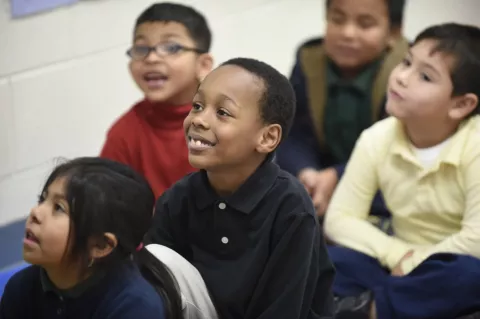All students deserve great public schools–schools that instill a love of learning, that prepare them academically and socially for bright futures. But how do we know what makes a public school great? How we can bridge the gap between our experience today and our vision for the future?
More than a decade ago, we realized that educators, allies, families, and students need a common framework to say: this is what our 50 million students deserve. This is what every district, and every state, must support. As Dr. Jerry Weast, former school superintendent in Montgomery County, Md., said: "You cannot be successful and move forward if folks aren't on the same page." So we developed the Great Public Schools Framework. The Framework allows us to be on the same page, so we can raise our voices and use our collective power to pinpoint gaps between what currently exists in our states, districts, and schools, and what is needed to create a great public school.
You cannot be successful and move forward if folks aren’t on the same page –Dr. Jerry D. Weast
Great Public School Indicators
Through three years of research and collaboration with leading education policy and practice efforts, we have identified and the seven areas critical to the success of public schools and students. They are:
- School Readiness: Our schools provide quality programs and services that meet the full range of all children’s needs so that they come to school every day ready and able to learn.
- Standards and Curriculum: Our schools set high expectations and standards with a rigorous and comprehensive curriculum for all students.
- Conditions of Teaching and Learning: Our schools provide quality conditions for teaching and lifelong learning.
- Workforce Quality: Our schools have a qualified, caring, diverse, and stable workforce.
- Accountability and Assessments: Stakeholders at all levels share responsibility for appropriate school accountability.
- Family and Community Engagement: Our schools facilitate parental, family, and community involvement and engagement.
- School Funding: Our schools are supported by sufficient, equitable, and sustainable funding.
Fulfilling these indicators will help us raise achievement for students, close the achievement gap, and ensure that all children, regardless of background, color, culture, or zip code can reach their potential.

Applying the Indicators
The seven indicators above are further defined by 31 subcriteria, and more than 200 research- and evidence-based qualitative and quantitative indicators at the state, district, and school levels.
The indicators are grouped by Resources, Policies and Practices, and Outputs. Resource indicators refer to the human capital, technical assistance, and funding that are needed to achieve outcomes. Policies and Practices are the indicators that need to be implimented to achieve outcomes. Outputs, such as “Percentage of students with less than 10 absences in a school year,” are a result of the resources invested and the policies and practices implemented, and measure proximity to the outcomes, or goals.
Download the framework, below, to begin your great public school journey.
Downloads
- gps-framework_-accountability-and-assessments.pdf
- gps-framework_-conditons-for-teaching-and-learning.pdf
- gps-framework_-family-and-community.pdf
- gps-framework_-school-funding.pdf
- gps-framework_-school-readiness.pdf
- gps-framework_-standards-and-curriculum.pdf
- gps-framework_-workforce-quality.pdf
- gps-indicators-framework.pdf
- a-new-vision-accountability-task-force.pdf
- school-improvement-guide.pdf

